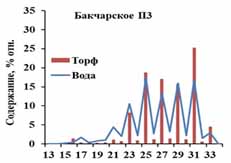Comparison of organic compounds content in peat deposits and water of different mire types in the southern taiga subzone of West Siberia
DOI:
https://doi.org/10.31251/pos.v8i4.326Keywords:
raised, transitional and lowland mires; fens; bog water; peat; distribution of organic, acyclic and cyclic compounds.Abstract
The aim of the study was to examine the composition of organic compounds in the water of different mire types in the Tomsk region, depending on the compouns' content in peat deposits.
Location and time of the study. Water and the corresponding peat were sampled in July-August 2016 in the raised bogs, transitional mires and fens of the southern taiga subzone of West Siberia within the boundaries of the Tomsk region. Peat samples were taken at a depth of 30–60 cm.
Methods. Extraction of organic compounds from the water samples was carried out with 10% hexane solution in chloroform. Peat samples were dried and crushed, and organic compounds from peat were concentrated by extraction with 7% of methanol solution in chloroform at 60°С. The individual and component composition of organic compounds in water and peat was studied by chromatomass spectrometry using a magnetic chromatomass spectrometer.
Results. In the peat–water series, individual groups of biomolecules were found to be unevenly distributed. Among the acyclic structures in mesotrophic peat with wood and cotton grass and Sphagnum peat, n-alkanes dominated (28-65%), whereas in sedge and hypnum eutrophic peat n-alkanes accounted for no more than 30%. N-alkanes also predominated in water (38-54%), with the exception of the Tisanskoe transitional mire and the Ishkol fen, where low-chain ethers of fatty acids were dominant. A high content of the latter was also observed in the water of the raised bogs. Carbonyl structures, n-alkane–2-ones, predominated in sedge and sedge-gypsum eutrophic peat. Carbonyl structures, n-alkane–2-ones, predominated in sedge and sedge-gypsum lowland peat, and diketones-diones were also found in some peat samples. The proportion of carbonyl structures in water was significantly lower, and compounds with a hydroxyl group, n–alkanol were common in them. Wood-fluff, sedge and sedge-hypnum peat were enriched with acyclic compounds. Cyclic structures prevailed in the upper peat and one of the transitional peats. It was shown that the composition of cyclic compounds in sphagnum bog peat was dominated by pentacyclic triterpenoids, wh whereas in transitional mire moss it was dominated by diterpenoids, and in wood-fluff and sedge-hypnum by steroids. The ratio of the individual groups of cyclic compounds in the water of most mires was close to that in the corresponding peat. Only in two mires the ratio between the groups of cyclic structures in water and peat differed.
Conclusions. The analysis of the organic compounds composition showed that acyclic compounds in peat and water, along with the n-alkanes prevalence, contained in large quantities compounds with a carbonyl group, such as n-alkane-2-ones, diketones and n-aldehydes, and long–chain esters in water. The composition of cyclic compounds of raised peats was dominated by pentacyclic triterpenoids; whereas steroids dominated in the sediment-hypnum lowland and wood-fluff transitional peat, diterpenoids prevailing in the moss transitional peat. Bog waters mostly inheriyclic compounds of the corresponding peats.
Downloads

Downloads
Published
How to Cite
Issue
Section
License
Copyright (c) 2025 The Journal of Soils and Environment

This work is licensed under a Creative Commons Attribution 4.0 International License.






